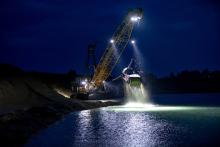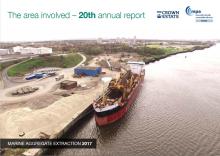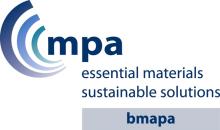
The Geological Survey of Denmark and Greenland (GEUS) recently hosted the European Marine Sand & Gravel Group’s (EMSAGG) latest knowledge-sharing workshop. Aggregates Business editor Guy Woodford was among those attending the event at the GEUS offices in Copenhagen.
The great diversity within Europe when it comes to marine sand and gravel extraction policy and licensing, regulation of the sector, and marine aggregates pricing, is very apparent listening to the various high-calibre speakers at EMSAGG’s workshop on Friday 22 March 2019.
Representatives from more than 25 leading European marine aggregates businesses were in the audience listening to presentations from Jørn Bo Jensen, PhD, head of GEUS Marine Geology department; Cees Laban, of Marine Geological Advice (chair, EMSAGG); Christian Abildtrup, chief geologist
During his presentation, Cees Laban said: “The growth in global demand for sand and gravel for various applications is leading to increased use of marine-based resources, creating a long-term responsibility to manage and archive marine sand and gravel extraction, not only in Europe but worldwide. The increased use of the seabed space by the construction of large windmill parks, with their interconnecting cables and cable routes to the shore, force resource managers to explore new areas, where, for instance, unexploded objects are hidden, and where advanced geophysical methods are needed for their detection.”
Laban praised Vince Beiser’s 2018-published book, The World in a Grain: The Story of Sand and How It Transformed Civilization, for highlighting just how vital the sand and gravel sector is at a global level. “I’ve been involved all my working life in sand, but I didn’t realise it was used for so many purposes. What was frightening to read about was the increasing shortage of sand of the right quality. The importance of sand and gravel has been a long-term focus of the UN’s [
Established in 1998 by European professionals, EMSAGG - www.ciria.org/emsagg - is an independent body which draws together stakeholders including dredging organisations, European government departments and agencies, regulators, economists, resource planners and environmental and academic research bodies. Providing a forum for the exchange of ideas and learning across Europe, EMSAGG has hosted workshops and conferences in a variety of European countries over the last two decades. Istanbul, Rome, Bologna, Brussels, Ostend, Utrecht, Haarlem, Le Havre, Brest, Gdansk, London, Edinburgh, Southampton, Cork and Dublin are just some of the locations of previous EMSAGG events, reflecting the pan-European focus of the association.
NCC is one of the largest players in the SEK 15,000 billion/year (€1.41bn) Nordic construction market, with a market share of 4%. Speaking about how the company operates its three businesses – Construction & Civil Engineering; Industrial; and Development – and their use of high-quality marine sand and gravel sourced from aggregates wharves, Christian Abildtrup said: “The demand for [marine sand & gravel] acreage is the most important discussion we have. Competition for it is increasing. Denmark is our biggest infrastructure projects market. We need about 140% of Denmark just to accommodate our activities in the country. That’s because we don’t have big marine gravel deposits in Denmark.”
Abildtrup said that marine aggregates for the building industry are primarily used in concrete. He suggested there may be a paradox at play when considering marine sand and gravel supply and demand. “The industry is trying to get more acreage, more gravel pits and more marine areas in order to offer better supply at lower prices. However, the rest of society is trying to limit the industry’s access to acreage, leading to poorer supply and increased prices.”
Ilse Herpoelaert, a marine aggregates and general economist for FPS Economy, highlighted the diverse regulation among European nations when it comes to the marine gravel and sand industry and how this made it very difficult to compare product pricing. She said that EMSAGG could play an important role in speaking to local contacts to help to make pricing more transparent.
Herpoelaert said France had three levels of marine gravel and sand prices which depended on nine factors, including extraction vessel piloting, unmooring and different taxes. In Germany, the marine sand and gravel price is affected by a mining levy that is calculated as a percentage of the extracted materials’ market value. A field royalty per m² of extraction is also charged. Meanwhile, the UK sets a yearly marine sand and gravel price depending on the market price.
Laura Addington, of the Danish Environmental Protection Agency, described how the percentage of marine sand, gravel and stone extraction in Denmark in overall land-marine extraction totals had risen in the last two decades. In 2017, the latest available figures, 25.1% (8,818,000m³) of 35,154,000m³ of the country’s sand, gravel and stone extraction that year was marine sourced. That compared to 16.6% (5,394,000m³) of 32,450,000m³ of Denmark’s sand, gravel and stone extraction in 2001.
Addington said that the Danish Environmental Protection Agency’s (DEPA) work said legislation and permission rights for land and marine sand and gravel extraction had to be balanced between securing sufficient materials for Danish society’s ongoing development and construction works and protecting nature and the environment. She explained how there are three tyres of extraction site – common, auctioned and builders – with different m³ material extraction pricing. Common sites are fixed in price and are the most expensive. Exclusive sites, as their name suggests, are for one licence holder only. Auctions for an exclusive site are held twice a year. Each bidder can request a specific area from which they want to extract. Chosen areas are then put up for auction with each bidder disclosing how much they are prepared to pay per m³ extracted – with the highest pledge winning. Bids can be linked to a harbour extension or another large-scale project. Extraction sites vary in price depending on the bid fee. Builders
’ sites are also exclusive and can vary in price. Many are free.
Touching on Danish sand and gravel extraction regulation history, Addington said that since 2010 more emphasis had been given to new types of extraction sites, with all land and marine sand, gravel and stone extraction licence applications needing to include detailed geological resource mapping and a full Environmental Impact Assessment (EIA). Since 2015, regulation has also focused on generating more competition between licence holders and in setting a firm date of expiry for site extraction.
Addington said DEPA is also engaged in a new sand and gravel extraction site compliance monitoring project using AIS (automatic identification system) technology. AIS analyses DEPA-imputed historic sand and gravel site extraction data to identify current extraction activities and estimate real-time residual volume. She said an ability to carry out comprehensive real-time compliance monitoring may replace current quarterly compliance monitoring reports. She also discussed how marine extraction is to be included alongside fishery, transport, energy and environmental protection in a new Marine Spatial Plan (MSP) due to be published in 2021.
Nick Everington, The Crown Estate marine minerals portfolio manager, said that 19-20 million tonnes of sand and gravel were dredged each year from British coastal waters, equating to 25% of sand and gravel demand in England and Wales, 8% of primary British aggregate demand, 50% of primary aggregate demand in London and 80% of sand demand in South Wales. Everington said that current national estimates suggest there are 21 years of primary aggregate production permitted, with an estimated 343 million tonnes of current primary reserves.
Describing the varying logistics involved in delivering 8,500 tonnes of marine-extracted sand and gravel, Everington said it could be done using one dredger, nine barges containing 1,000 tonnes each, 95 train hopper wagons of 90 tonnes, or 425 aggregate lorries, each containing 20 tonnes of material.
Further figures quoted by Everington showed that as of March 2019, The Crown Estate had awarded sand and gravel extraction licences for 65 areas, with applications to extract in 12 further areas under consideration. The 65 active sand and gravel extraction areas covered a potential extraction area of 1,031km², with 19 million tonnes extracted out of 88km² dredged from UK waters in 2018.








